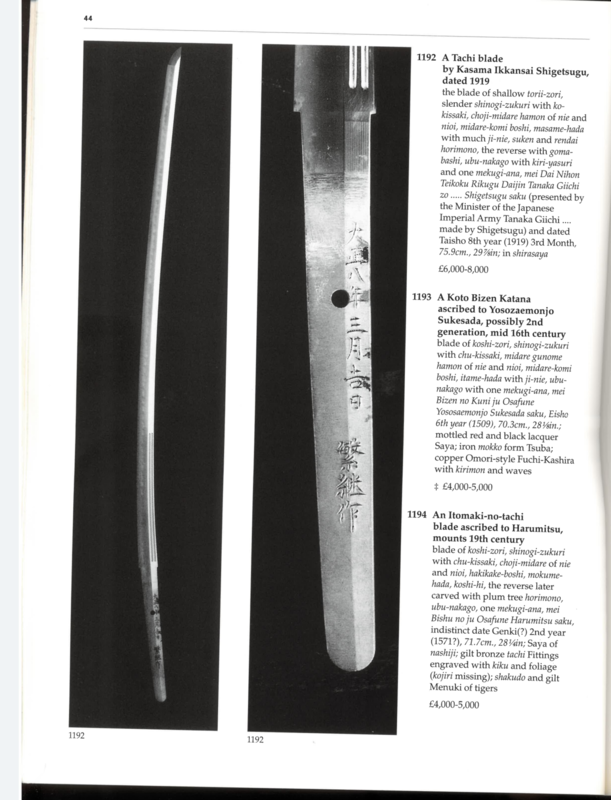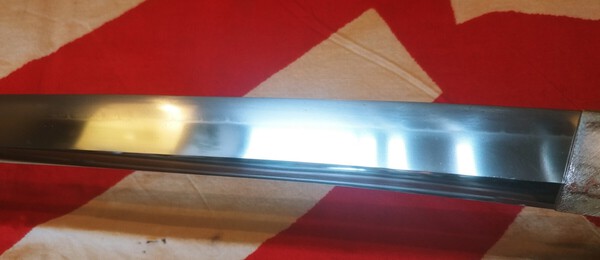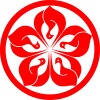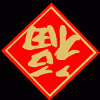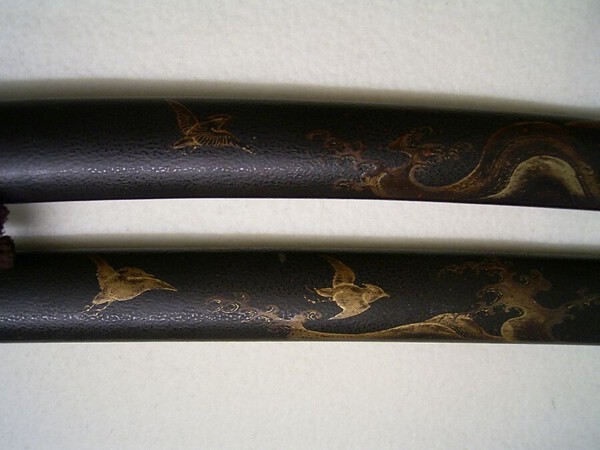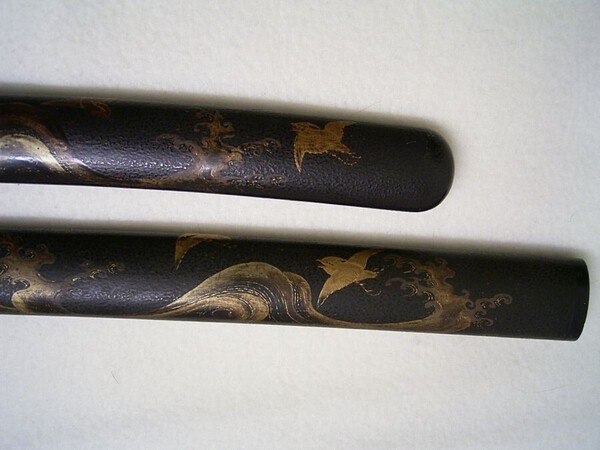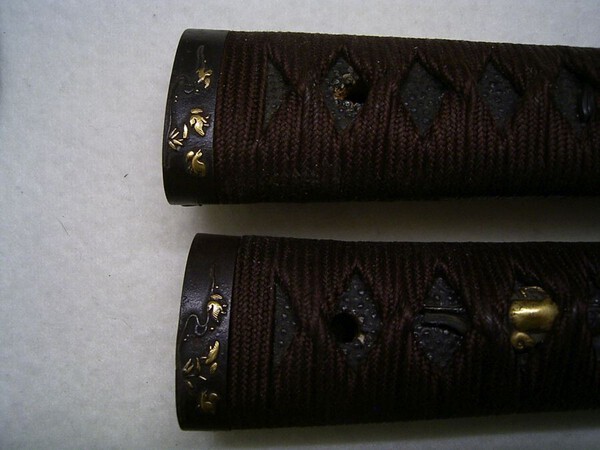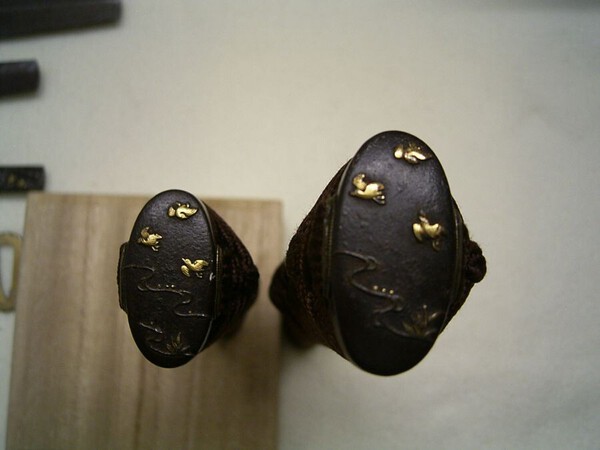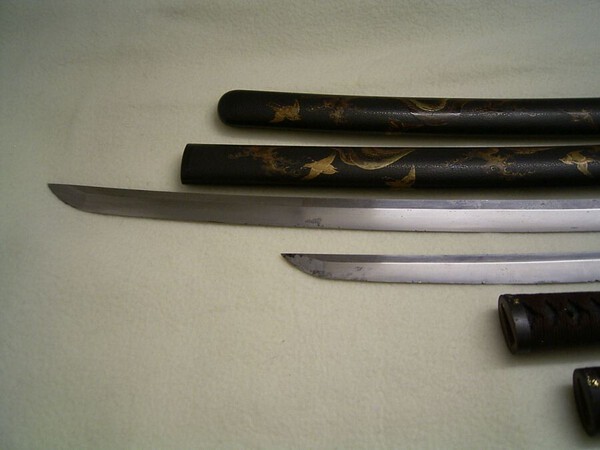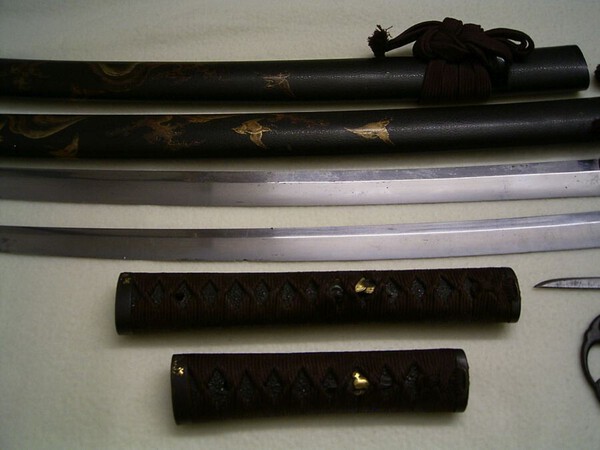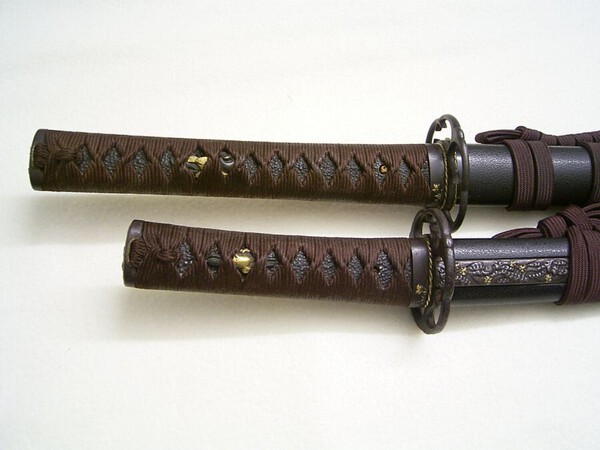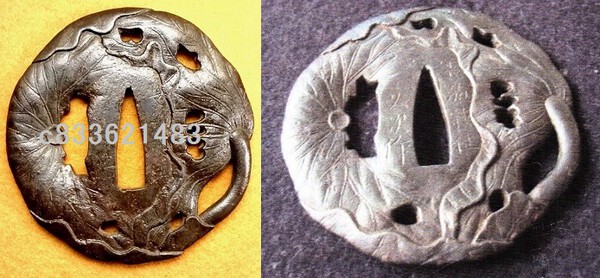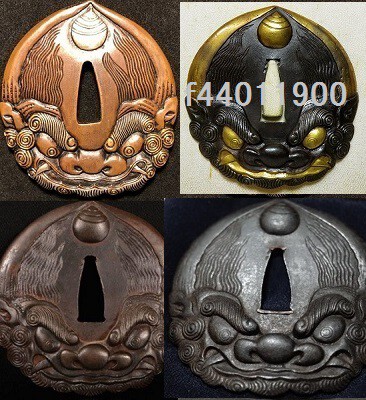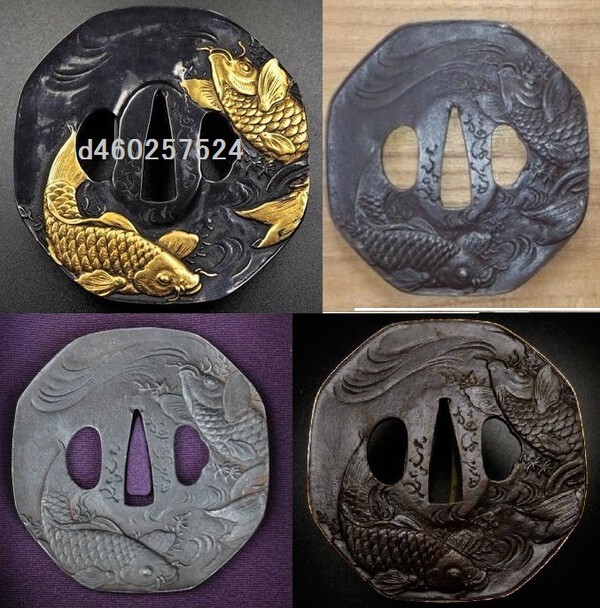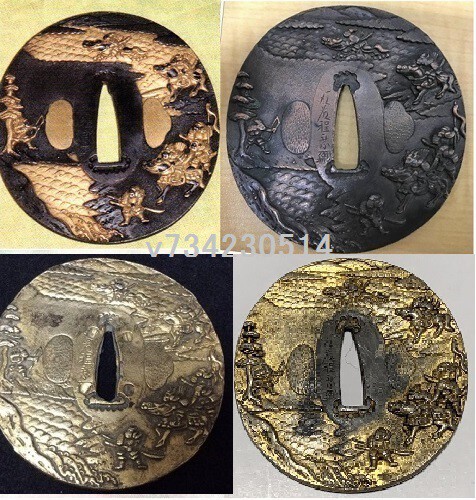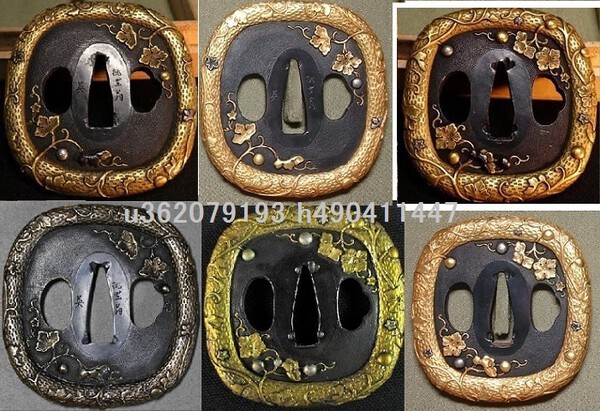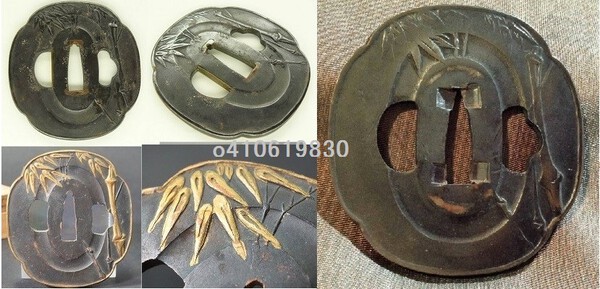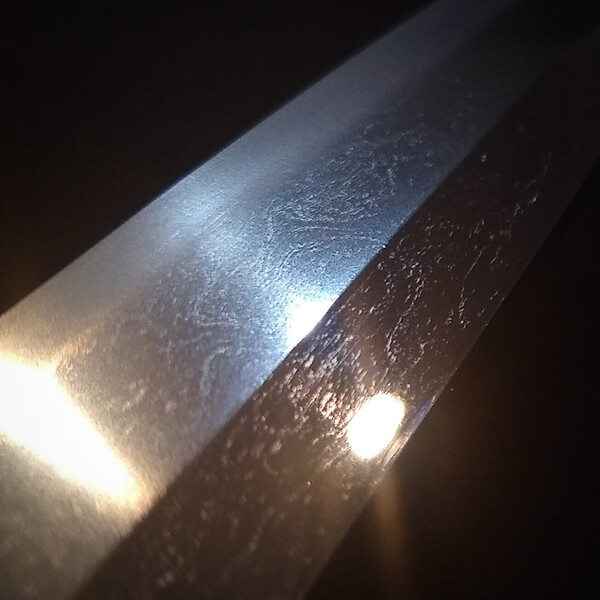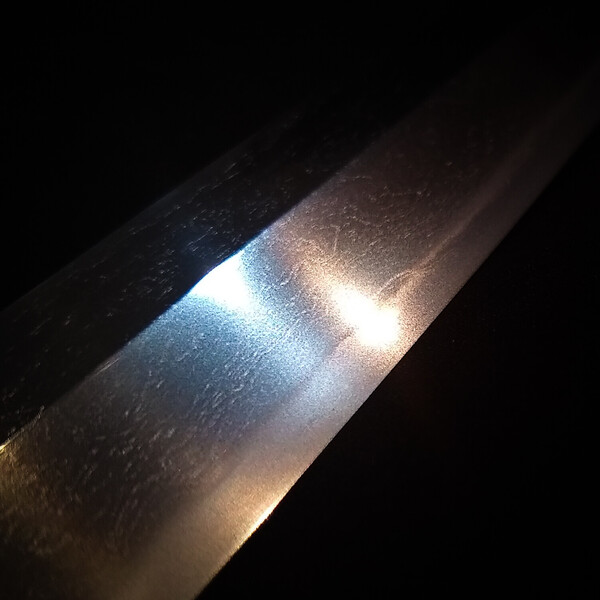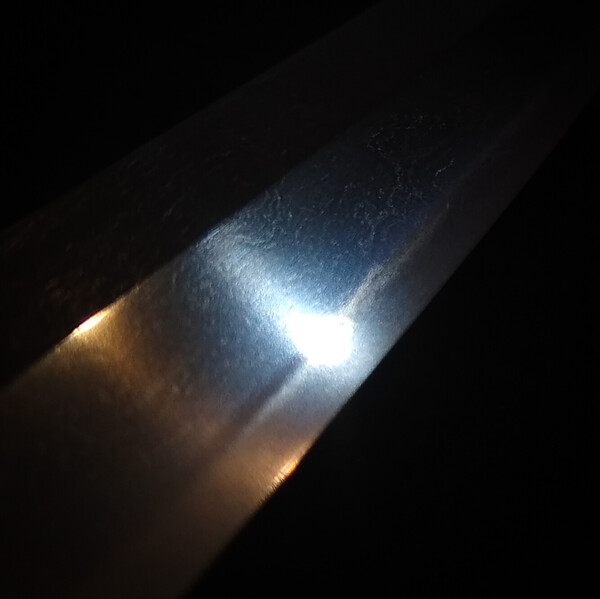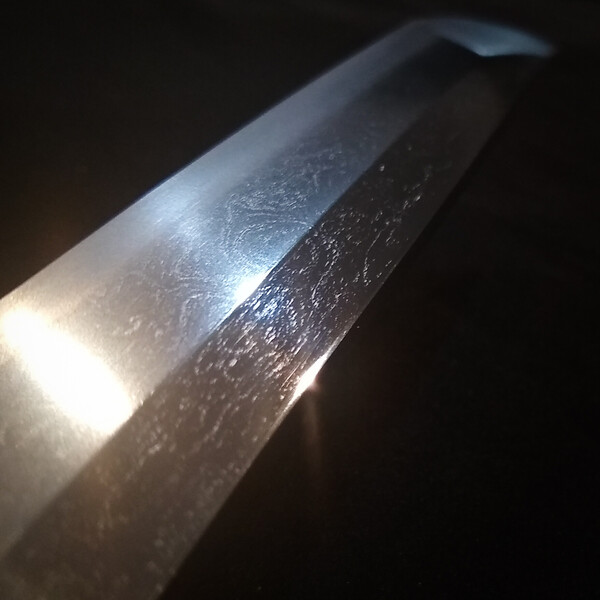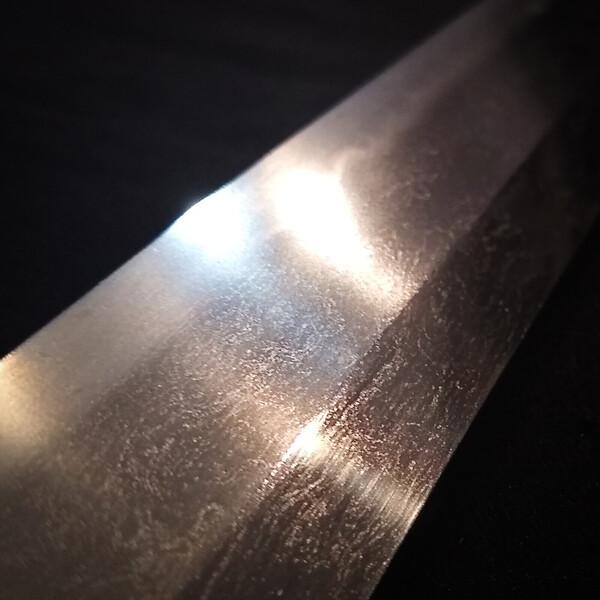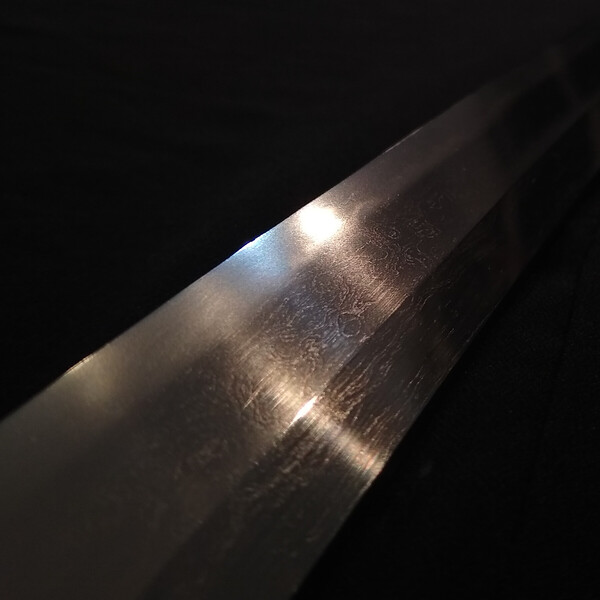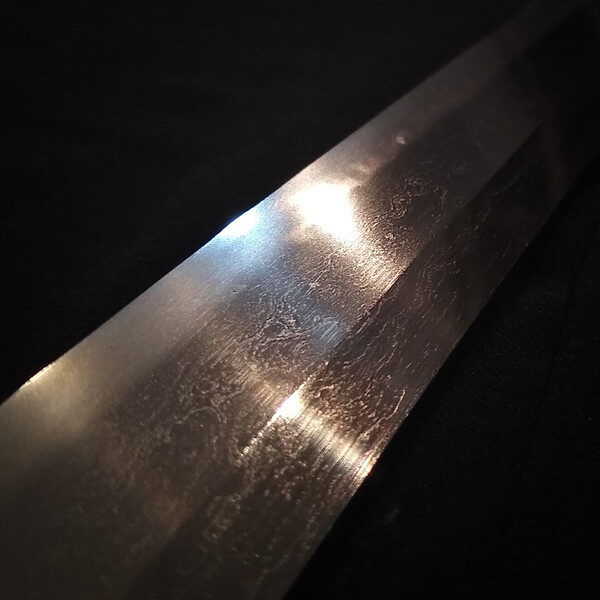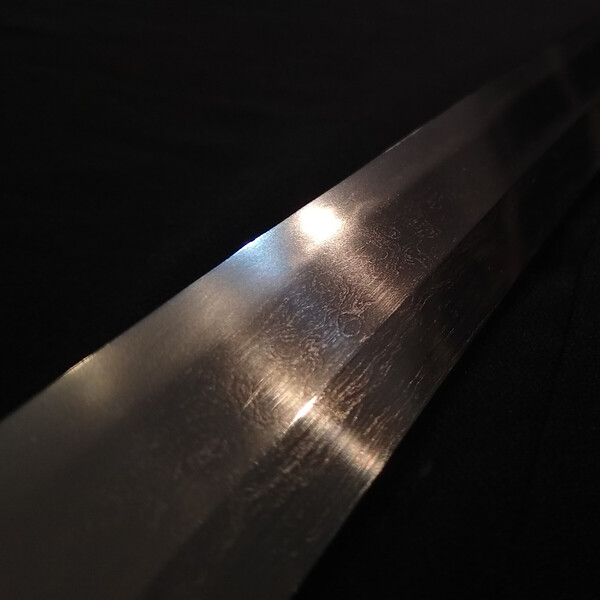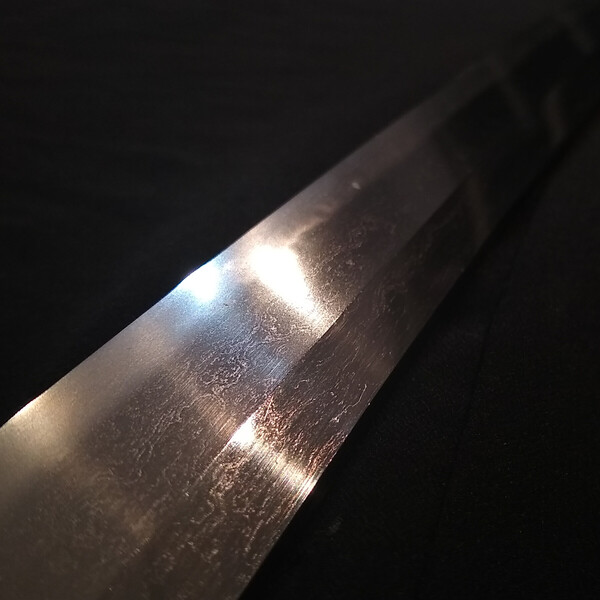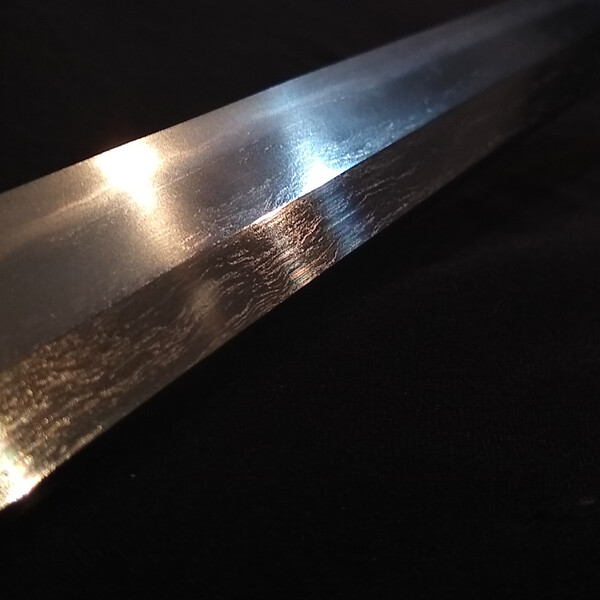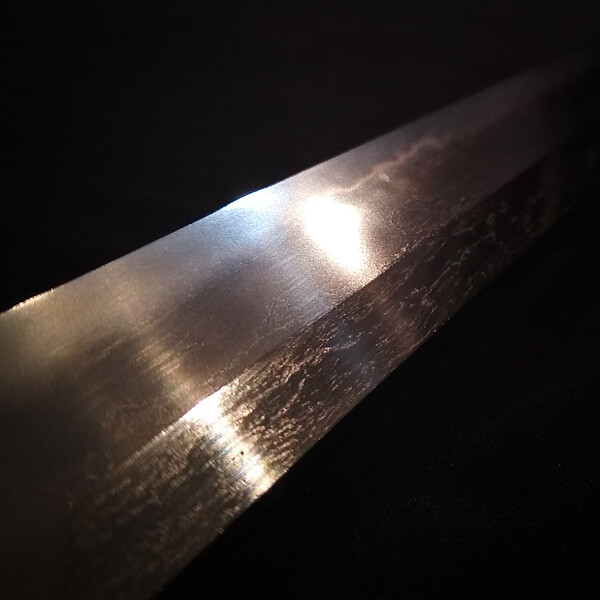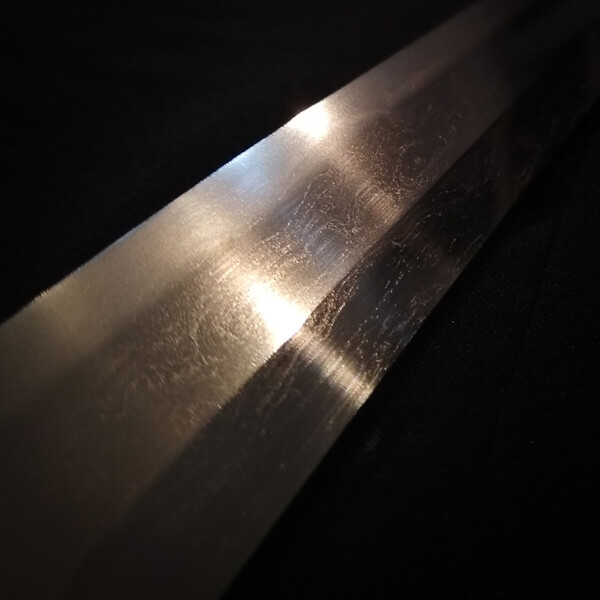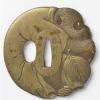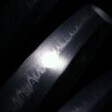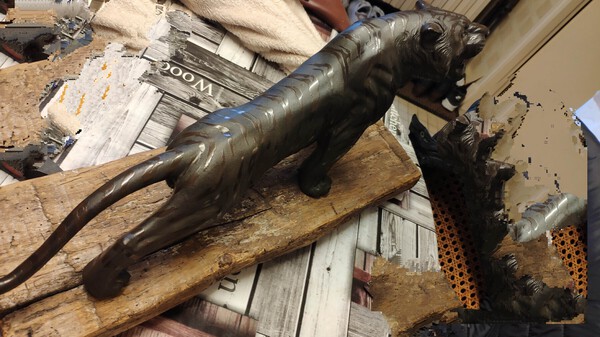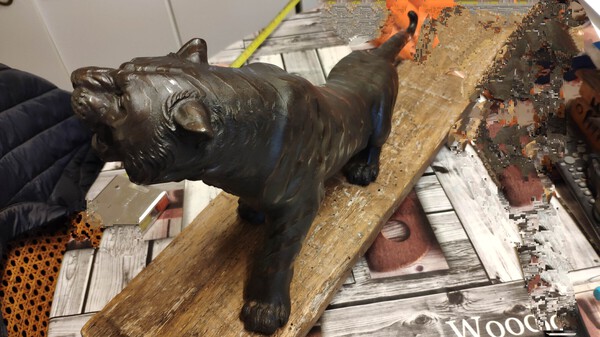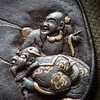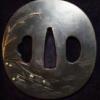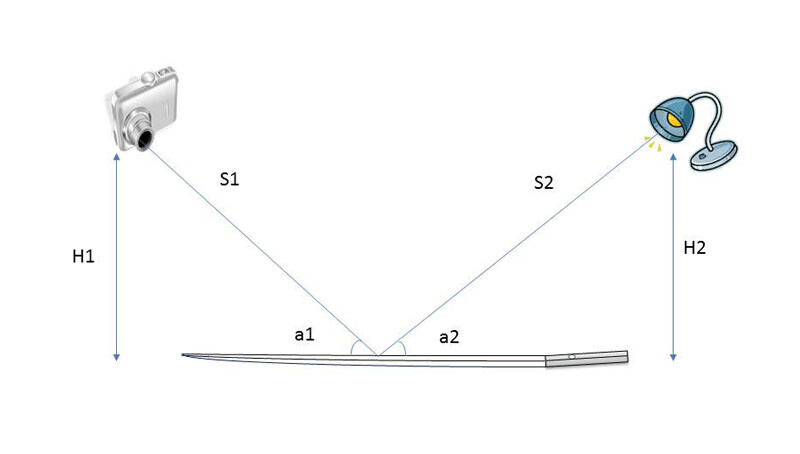Leaderboard
Popular Content
Showing content with the highest reputation on 01/30/2021 in all areas
-
7 points
-
6 points
-
I know we have a separate topic of Show Us Your High Class Gunto. But many WW2 swords smiths have made nice traditionally made blades from 1876-1945. With members like "mecox" doing spectacular research on WW2 sword smiths, I think this new topic could throw some light on some sword smiths and their work, and hopefully kindle interest in the blade, not just the Koshirae. You never know, we may find some rare or poorly documented swords and smiths. If your posts could be supported by photos, oshigata, descriptions, and any other relevant information, I think a great reference topic could be established. OK, so here is a contribution to kick things off.... A (Mano) MASAYASU medium-grade grade gendaito, no date no stamps, in early '98 mounts. Mei reads Bishu ju Masayasu. The hada is flowing masame/mokume, with choji gunome midare hamon. I only hope there are better photographers out there! So I would ask the forum administrators to let this thread run, and see where it goes, a lot of time is spent discussing Chinese fakes, and machine made Showa-to, and I am sure this topic will help raise intertest in Gendai. P.S. Hamon looks Suguha in photos, but the Keisho polish disguises the features, easily seen in the hand.4 points
-
3 points
-
3 points
-
Hey Tosogu group- First tsuba I got on its ow n merits , I do have one other that came with koshirae this group helped me to identify awhile back. I normally stick to blades to avoid another area of appreciation (or money drain , heh). I always wanted a tiger piece and picked up this tsuba off Mr. Quirt while sword browsing. I have only a couple tosogu references, is this the kind of piece a school can be narrowed down to? Details from the listing were: early Momoyama or Muromachi, 7.65 cm x 7.436 cm x 5.24 at the mimi the plate itself is approximately 2.5 cm. It's a nice piece in hand to take a look at, especially in good sunlight. Cheers!2 points
-
Dear all I have recently acquired a NBTHK Tokubetsu Hozon Yoshiro Zogan tsuba signed, as per NBTHK paper, "Hiroshima Ju Ginza Chosuke". According to the seller the signature is "Hiroshima Ju GINYA Chosuke". I was not able to find any reference or information about the "Ginza Chosuke", but some about the "Ginya Chosuke" on the Kinko Jiten by Wakamatsu Homatsu. A rough translation of it is (please pitch in if you have a better one): Chosuke Living in Nagasaki, Japan. Named Ginya Chosuke, carved in brass flat inlay on a round iron base in Yoshiro Zogan style. Early Edo period. So this "Ginya Chosuke" seems to be spot on for the tsuba. style However I would like to hear your opinion about the NBTHK and seller attribution. If any of you have information about "Ginza Chosuke" or additional information about "Ginya Chosuke" that you care to share I would be grateful. Best Regards Luca2 points
-
I will be using this post to share some recent photos. In general these will not be swords that I am offering for sale, but instead will be coming from my collection and those of other collectors who have given approval to share the photos. I have also recently started photographing swords and fittings for auction houses, and some images may come from that source as well.2 points
-
Iga no kami kinmichi (shodai), Izumi no kami rai Kinmichi (shodai), Tanba no kami Yoshimichi (shodai). and Etchu no kami Masatoshi (shodai) are all brothers they are sons of Mino Seki Kanemichi.2 points
-
The issuing body did not collect the old system testimony, but simply declared it invalid. Originally, the certificate once issued should be valid as long as the issuing organization continues to exist. The turbulence of the past and the desire for new income are the background of this situation.2 points
-
Fair enough Mal. I get excited sometimes and run my mouth before I dig into the facts! I'll start tracking the Navy stamps and see what develops. I think it's going to be a tougher study, though, as there are less Navy blades to tabulate and my rough impression of them is that more so than Army, they aren't dated very often.2 points
-
While I agree that the chip could be removed by a competent polisher I would leave it alone, part of the swords history. I think you have a nice offering here. First two kanji are a slogan 必勝 Hissho! Certain Victory! The artist is Kato Jumyo 加藤寿命 There should be plenty of good info online. -t2 points
-
I would suggest a later date for the decorative work. Kata-kiri style cutting, the tiger's stripes, bamboo leaves etc, developed around the first quarter of the 18th century, ie; 1725 ish. Centred on the Yokoya school.2 points
-
Hello, sometimes great wishes come true, my first daisho. Everything fits together well, an identical outfit. The two blades seem to be old, I don't have much experience to judge that yet . A new polish of the blades is certainly no longer possible, the material does not allow it. A nice addition to my collection. Uwe2 points
-
For July. http://page.auctions.yahoo.co.jp/jp/auction/c833621483 http://page.auctions.yahoo.co.jp/jp/auction/p780233857 http://page.auctions.yahoo.co.jp/jp/auction/d460257524 http://page.auctions.yahoo.co.jp/jp/auction/v734230514 http://page.auctions.yahoo.co.jp/jp/auction/u362079193 http://page.auctions.yahoo.co.jp/jp/auction/h490411447 http://page.auctions.yahoo.co.jp/jp/auction/o4106198301 point
-
Hi guys, Just a quick note to let everyone know I've recently taken in about 20 to 25 pieces of kodogu (mostly tsuba) and I've started listing them to my site. Some very nice things here. This is an invitation to check in at https://www.japaneseswordbooksandtsuba.com/store/Tsuba-&-Kodogu; maybe something will speak to you. 13, I think, swords will be going up soon also. Stay well, Grey1 point
-
掛け軸 or 掛軸 kakejiku You will find millions unless you search for 日本刀の図, or 日本刀の押型 or some variations of these. -t1 point
-
1 point
-
1 point
-
Hi Carl, this statue is commonly seen in various auction houses in France and on the web: https://www.google.com/search?q=bronze+tiger+Japan&rlz=1C5CHFA_enFR917FR918&source=lnms&tbm=isch&sa=X&ved=2ahUKEwj-sdGUlMTuAhWl0eAKHZiWA4gQ_AUoAXoECBIQAw&biw=1920&bih=9831 point
-
1 point
-
1 point
-
Tiger in bamboo is a very nice theme. I had one too. tiger and bamboo - YouTube1 point
-
Dear Chris. A short while ago there was a thread discussing a tsuba that was for sale online. The tsuba was papered but stated that the decoration on the tsuba was added later. In that case the addition was quite evident. I would imagine that a similar outcome would happen for your tsuba but it might not. For what it's worth I don't think you have very much to gain from papering this one. Enjoy! All the best.1 point
-
Really nice blades Brandon, it would be great if you could show the Nakago on each, and describe the hada and hamon. I am hoping that in the future, if someone is searching YASUNORI for example, not just great photos, but information pops up as well. This could make for a very informative research site.1 point
-
Earlier in this thread was a post about used storage boxes with Christies labels attached - well how about second hand Shinsa papers in bulk! https://www.jauce.com/user/vzmkp83951 This seller could supply you with a wealth of certificates for a much cheaper rate! I have said this before "what do you actually get when you buy papered pieces?" What are you paying the money for? The object or the piece of paper? Seems the paper is not worth that much really.1 point
-
A good Gendai smith (rated Chu Saku) and an interesting Mei with that slogan, a very good deal for the new or experienced collector!1 point
-
G'day Yas, With the blade in hand you can see the file marks on the nakago. The particular mei you have circled is subtly different from the others you have illustrated including mine. My sword has NBTHK tokubetsu hozon papers. I didn't realize that this smith had swords that had papered Juyo. Cheers, Bryce1 point
-
Assessing nihonto is among the most detailed artforms you'll ever see! The amount of minutiae can be daunting.1 point
-
1 point
-
Hey, Hamfish, show us the rest of the - ahhh - article. I want to read the whole thing and see how it ends. P1 point
-
Interesting, and a good reminder that we depend on invisible people correctly doing their job. I always assume that shipping a package isn't rocket science but it's surprising the number of mistakes I've seen which made me wonder what had happened. Once I had a package from Japan (containing a tsuba) sent to a remote town in France (Seyssinet Pariset) where I've never been (and will probably never go). The correct address was in Paris. I will never know how Paris magically became Seyssinet Pariset during the shipping. It took me 10 frantic calls to the carrier hotline and several emails to the Japanese seller to get this sorted out. Another time, I got a katana sent from Japan automatically sent back to the seller with the rationale "Delivery refused" (supposedly by me). At that time, I was at home, waiting for the delivery, noone rang at the door... That feeling when you refresh the tracking page and read "Package sent back to sender" The package was then sucked into a black hole for 6 weeks with no way to know if it was still in France, in transit to Japan or lost... Eventually the package showed up in Japan and was delivered to me in 3-4 days.1 point
-
Hi Chris, At first glance there looked like casting marks around the rim - but on closer inspection I noticed the fukurin, nicely done at that, lighting is always a problem especially with old eyes. The crimping matches the iron rim, I bet it sets off the rest of the guard in sun light, I can't give a school but it looks some age and the skill level is excellent. Good find !1 point
-
I sent a complete HKS silent flow exhaust system to the UK, and even with the tracking number it was ‘lost’ after arriving at Crewe(?) where the central customs depot is, right? Eventually they sent me a photo of an old rusty system standing in a corner. “This it?” Nope. In the end it did magically turn up, but probably because I had kicked up such a fuss.1 point
-
坂一貫齋繁綱作 – Saka Ikkansai Shigetsuna saku Ref. 刀 坂一貫斎繁綱作 平成丁亥年九月吉日 Katana [Shigemasa] (samuraishokai.jp)1 point
-
I dont see modern. I know forced aged and this isn't. Nakago is nothing like fake chinese from that era. Shots of kissaki please. Also any activity in the blade.1 point
-
1 point
-
Hi James, yes there are many examples of hadaka-yaki being executed to an extreme degree of skill in the Ichimonji school. However, the craftsmen I mentioned were referring to more recent attempts at hadaka-yaki (shinshinto – gendaito). I thought this was inferred by your original question “modern smiths have yet to rediscover "true" utsuri” but reading my post back I don’t think I was clear in this point. These two different heat treatment methods can produce very different results with utsuri, and while I don’t necessarily agree with the view that one method is better than the other, I do understand that some craftsmen may prefer one method over the other. From my own perspective, I’d say that just like every other feature of Nihonto, not all utsuri is created equal. Being able to judge the quality of the activities in the steel is a large part of judging the quality of a Japanese sword. To me this has less to do with the methods used to create the sword, and more to do with the degree of skill and experience that went into these methods. But I’ll add that these views were shared with me by senior craftsmen who I respect, some of whom have dedicated their lives to reproducing Bizen style swords, so I wouldn’t dare assume I know more than them on the subject. What is for sure in this field of study is… the more we learn, the more we realise we have more to learn!1 point
-
What is "true" utsuri? What isn't? The question in this thread could be interpreted in different ways, I believe James is probably referring to hadaka-yaki, but I'll touch on a few different things that come to mind. 1) Yes, there are swords on the market (particularly coming from Japanese auction sites) that have fake utsuri. It’s a chemical technique applied to the blade in the polishing process, which is designed to resemble utsuri on certain angles. However, the examples I’ve seen have been rather crude and obvious, and can easily be detected through pictures. I’d also like to make clear that this technique is not being applied by traditionally trained togishi, I’ve only ever seen it on blades that were defiled by hobby-polishers/self-taught hacks. If you want more info on how to spot fake utsuri, please read the following link: https://www.facebook.com/toukentogishi/posts/2401556073244615 If you don’t do facebook, it was also posted on NMB: https://www.militaria.co.za/nmb/topic/28800-warning-about-fake-utsuri/?tab=comments#comment-291807 2) There is another type of fake utsuri that appears in Nihonto, though you wouldn’t really refer to it as fake, as it’s very much a naturally occurring effect, not an artificial effect applied in the polish. It’s called tsukare-utsuri. Tsukare-utsuri literally translates as ‘tired utsuri’ and it occurs when shingane (core steel) is exposed. More often than not it can be found in lower-quality work of the Muromachi period (known as kazu-uchimono) which is known to have especially thin kawagane (skin steel). Tsukare-utsuri forms a loose/hazy utsuri-like effect in the steel that… - sometimes appears only around the border of where kawagane becomes shingane. - sometimes it completely fills that area of shingane. - or sometimes appears in patches within that area of shingane. In any case, it doesn’t look very appealing, it's definitely not a desirable trait in a sword, and you should be able to recognise it as something other than "true" utsuri. 3) Then there is the question around hadaka-yaki (heat treatment without clay) which is most likely what the question in this thread is about. During my training I was lucky enough to have quite a few conversations regarding utsuri with other craftsmen, and I get the impression that some of them believe that the utsuri produced when hadaka-yaki is performed on a blade is not really considered “true” utsuri. I recall one such conversation with several togishi at NBTHK kantei-kai. There was an exceptional Naotane which had very strong utsuri, and I was keen to understand why it was so much stronger than utsuri I’d seen in his work before. It was explained to me that “yes, this utsuri appears strong, but… this is only hadaka-yaki, and Naotane rarely used this technique”… implying that hadaka-yaki was a lesser way of achieving utsuri. I’ve heard similar remarks from tosho who work at producing utsuri when using tsuchi-oke (applying clay for heat treatment). Apparently, producing a clearly visible utsuri on a consistent basis is more easily achieved when using hadaka-yaki, but that type of utsuri can often appear wild and unrefined. So it's viewed by some as a greater achievement to produce prominent utsuri using tsuchi-oke. It’s a fascinating topic that deserves further study and debate, but I won’t wade into those depths today. I will say however that from recent efforts I've seen, it seems modern tosho are continuing to advance their abilities and re-discover the "secrets" of utsuri using both methods. Lastly, I’ll add a little article I posted a while ago, it’s a beginner’s guide to utsuri that should give you a little more info and some instruction on how to view it properly: https://www.facebook.com/toukentogishi/posts/1109394242460811?__cft__[0]=AZX5euUw0LcK-KtWaluQagI_Mp3mJ_MjHaxXY3D8nwx2FUANlNbxuChojfhd7LXkGKTJPIQa53xCp92Q9iuUGaQhj2gI1DAz03C4pGBNqEbXGglfyD-a1360xzhwIr8ZhQmn_ljmPPS351Mu31OHJynoJNKq8gQFGloA9qcDyRHbbp6-yAOqH73jfStPElKolfI&__tn__=%2CO%2CP-R1 point
-
OK, here we go! The aim of this topic is to share photography tips with those who are interested in improving their nihon-to photographing skills. If you have succeeded in taking a picture that shows some characteristics of nihon-to in a way you are happy with, please tell us how. Maybe this topic helps us to move towards the ultimate goal (maybe impossible one): a photograph of a blade, showing details of yakiba and hada over the entire length of the blade! I give an example of the way I’d list the parameters. I am not an expert in photography, nor a native English speaker, so please feel free to correct/suggest! Also, the example picture is not as good as many seen on this forum recently! Blade: Mumei kanmuri-otoshi wakizashi with naginata-hi, nagasa 51 cm. What did I want to show with this photograph: The yakiba in (almost) full length Light source type: incandescent light bulb (spotlight), 40 W, 2 pcs Light source-blade distance (S2): 2 m Light source angle (a2): approx. 12 deg (lightbulb 1); 17 deg (lightbulb 2) Light source elevation from blade level (H2): 40 cm (lightbulb 1) 60 cm (lightbulb 2) Ambient light: daytime, indoors, room lights off Camera-blade distance (S1): 2 m Camera line of sight angle with blade (a1): approx. 15 deg Camera elevation from the plane defined by the blade surface (H1): 50 cm Camera type: Canon EOS 450 D Objective type: Canon EF-S 55-250 mm (I used approx. 150 mm focal length) Image stabilizer: Yes Camera pedestal: Aluminum tripod Flash: No Trigger: self-timer 2 s Shutter speed: Auto Exposure measurement: spot measurement close to the brightest spot Aperture: 30 Focus: manual Image postprocessing: crop, compress, slightly adjust brightness. Sample Picture: If you do not know some parameter, just leave it blank. Measurements do not need to be accurate. Please feel free to use imperial measurements if that is more convenient. Please give comments: is this understandable? Is there anything else that should be added into the listing? Veli1 point
-
0 points







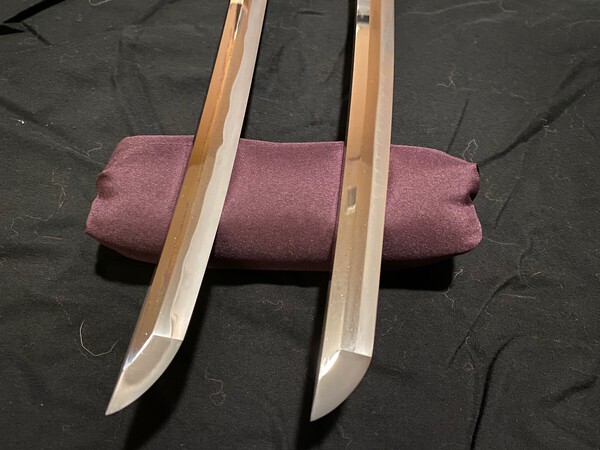



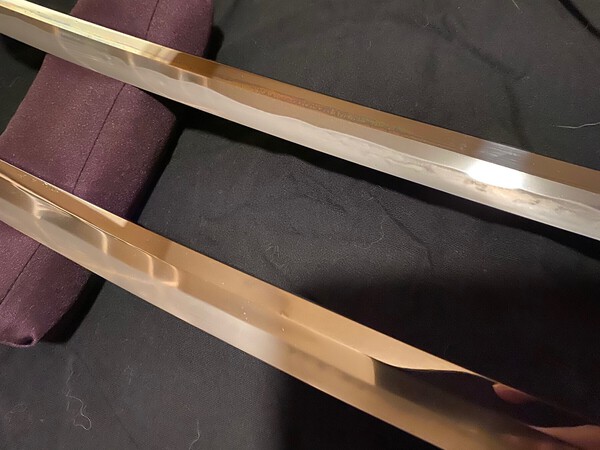
.jpg.902d10108b1117e2c644209154076cb5.jpg)
.jpg.771586582cb5945c2e0373018ddc6590.jpg)
.jpg.89042eb1e42b313435dc66d0bafd5e9e.jpg)
.jpg.162322380450c047e5271c8663575cf7.jpg)
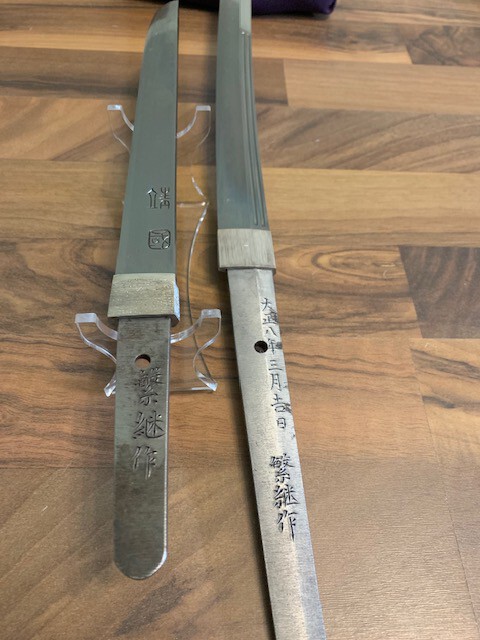
.jpg.55042c7e0057a20c67c34f448b0aac9c.jpg)
.jpg.545d60e6b6c2f6612fb6c1c634f207fb.jpg)
